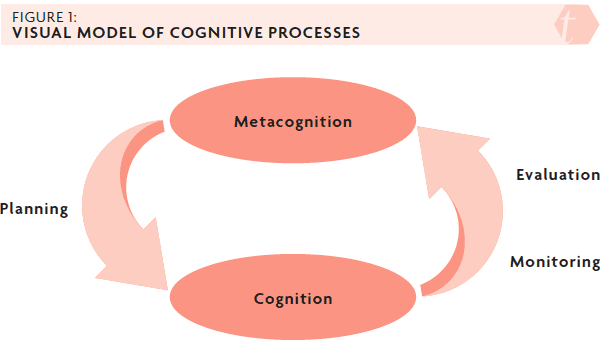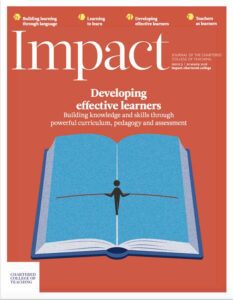Making sense of metacognition

Amy’s geography teacher has asked the class to prepare a short presentation about rainforest ecosystems. To plan this, Amy reflects on how she learned best on the last topic – using the school textbooks – and decides to read the relevant chapter before drafting her presentation points. However, when reading it, she decides that the chapter isn’t explained clearly enough to improve her understanding. She starts to panic, as she was relying on this. Then Amy remembers a geography website her teacher mentioned. She adapts her strategy and searches the website. This provides a more useful overview, and she uses the information to summarise some interesting facts. She reflects on the experience and decides that next time she will gather a range of resources before starting to research a topic, rather than relying on one source.
This short anecdote about Amy provides a familiar scene of schoolchildren grappling with their homework each evening in homes across England. When you dig beneath the surface of Amy’s actions, you begin to consider how she thinks hard about her learning. Here, she is proving to be a successful learner, having internalised some effective strategies for planning, monitoring and evaluating her geography learning.
Most often, such learner behaviours are hidden in plain sight. Students like Amy go on to prove a success in geography and beyond, whereas some of Amy’s peers simply flounder and fall away over time. Some teachers cultivate and nurture the metacognitive strategies used by Amy, explicitly naming them, guiding practice and promoting them daily, but many teachers do not do this so explicitly, so pupils may not develop the most effective strategies over time.
It becomes useful then to better define the key characteristics of effective learners, using well understood terms to underpin our practice in schools. The Amy example is a concrete example of metacognition and self-regulation. The Sutton Trust-Education Endowment Foundation’s Teaching and Learning Toolkit (Education Endowment Foundation, 2018) suggests that it is one of the most effective approaches for improving pupils’ attainment outcomes. So, how can teachers be helped to understand the terms? And how can the skills be developed and supported in the classroom?
Guiding teacher understanding of metacognition
Ask a staffroom full of teachers for a definition of metacognition and you will likely receive the familiar stock answer: ‘thinking about thinking’. The problem here is that such a definition is vague and slippery. It certainly does not help a Year 5 teacher on a wet Wednesday afternoon, or a Year 11 maths teacher tackling trigonometry after break-time! Other definitions, such as ‘learning to learn’, are equally vague and can actually promote the misconception that metacognition is a generic skill that is not bound to subject knowledge – that we are not actually thinking about something.
There is a wealth of evidence to better understand metacognition so that teachers of every key phase, key stage and subject can support learners like Amy to thrive in and out of the classroom (e.g. (Dignath and Büttner, 2008)). If we can better define metacognition, we can go on to make it concrete for teachers and pupils, whilst dispelling some common misconceptions about what metacognition is, and what it isn’t.
Metacognition is a part of self-regulation: those self-directive processes that direct our learning. As shown in the example of Amy, it requires:
- Knowledge of yourself as a learner (such as how Amy considers how she had performed successfully on her previous topic)
- Knowledge of appropriate strategies (such as how Amy drafts her presentation points and searches the internet)
- Knowledge of the task (such as how Amy knows that such a presentation requires the essential information offered by the textbook).
An effective learner will monitor their knowledge and cognitive processes, and use this understanding to make judgements about how to direct their efforts. Let’s take the following example. Try this straightforward mathematics multiplication: 155 x 3. You may find it easy, but you will still draw upon some tried-and-tested strategies based on your maths knowledge, and you will have a good sense of whether your answer is correct. Now, how about 145,343,233 x 3? Here, you need to reflect a little bit more. You may know that you have too limited an array of mathematical strategies for this challenge. You may be rapidly searching for a calculator, at least to check your answer. It is in those moments when you are selecting the best strategy that you are behaving metacognitively.
What we learn is that cognitive processes are controlled and adapted constantly. We are always making decisions about our learning in the moment. These decisions happen intuitively but, with explicit teaching and scaffoldingProgressively introducing students to new concepts to suppor, they can be better and more habitually enacted by pupils.
A visual model here is useful, as shown in Figure 1 (adapted from (Nelson and Narens, 1990).
This not a one-off process of discrete steps, but an ongoing cycle. As you progress through the task, you update your metacognitive knowledge (of yourself, your strategies and tasks), as well as updating your subject knowledge (in this example, Amy is learning about rainforest ecosystems, as well as learning about the best research strategies).
The cycle of ‘plan, monitor, evaluate’ and the different aspects of metacognitive knowledge (learner, strategies, task) are recurrent triplicates that are helpful in making the understanding of metacognition concrete for teachers.
Teachers can then consider these when setting learning tasks and supporting pupils to complete them. In an expert learner (as most teachers are), these processes are unconscious and automatic. In novice learners, however, it can be valuable to make them explicit. For students like Amy, and for teachers, defining and better understanding metacognition can prove a crucial support factor for success in school.
Dispelling metacognition misconceptions
One of the important ways for teachers to better understand metacognition and to teach pupils such strategies is to first dispel some common misconceptions about metacognition.
Misconception 1: Metacognition is a general skill that should be taught separately from subject knowledge
This is perhaps the most common misconception about metacognition. The clue is in the word: without cognition, there is no metacognition. Contrary to the misconception, metacognition is specific to the task and subject, and stronger where learners have a strong grounding in subject knowledge. It is, for example, very hard to have knowledge about how one can learn, such as through applying different strategies, in a subject without solid knowledge of subject-specific content and skills. For example, Amy must have a sound knowledge of the rainforest and its various levels, alongside the notion of an ecosystem, for her to decide the relevant evidence required from her textbook.
Therefore, teaching and practising metacognitive strategies must be done alongside subject content.Generic ‘learning to learn’ or ‘thinking skills’ lessons may be able to impart some useful overarching idea, but pupils can struggle to transferThe processes of applying learning to new situations generic approaches to specific subject domains. Self-regulated learning and metacognition have been found to be quite context-dependent, so how you best plan in Key Stage 2 art may have significant differences to planning strategies in Key Stage 4 maths. This does not, however, mean that metacognitive knowledge and skills will automatically develop through content knowledge teaching.
Misconception 2: Metacognition represents ‘higher order’ thinking and is therefore more important than mere cognition or subject knowledge
We know that metacognition is the knowledge of cognition and the strategies to regulate and control it. However, it would be a mistake to see metacognition as somehow ‘higher order’, hierarchically, and therefore more important than cognition (as Bloom’s taxonomy is sometimes misinterpreted as being a hierarchy that privileges ‘evaluation’ over ‘knowledge’). As has been pointed out, it is very hard to have knowledge about how competent you are in a given subject domain, or how best you can learn, without solid subject knowledge (Pressley et al., 2006).
For example, a student can use metacognitive planning strategies when drafting a GCSE essay about Shakespeare. But without knowledge of Shakespeare’s plays, language and the relevant social context, the essay will not be successful.
Metacognition and cognition then display a complex interplay as our pupils learn. We should look to develop both concurrently and not create false hierarchies where they do not exist.
Misconception 3: Metacognition is only developed in older pupils
A common misconception with regard to metacognitive knowledge and skills is that they are only developed effectively in mature young adults and not young children. We know from research that children as young as three have been shown to be able to engage in a wide range of metacognitive and self-regulatory behaviours, such as opting out of tasks based on their understanding of the ease of the task and the level of uncertainty (Whitebread et al., 2009). They also show greater accuracy on tasks that they accept to do than on tasks they don’t (Bernard et al., 2015).
There is clear evidence that the level of security and self-knowledge remains rather inaccurate until about eight years of age, with children being overoptimistic about their levels of knowledge (Clark and Dumas, 2016), but the overall trend suggests that forms of metacognition emerge early on in the lifespan.Ultimately, although older children do typically exhibit a broader repertoire of metacognitive strategies, younger children do generally demonstrate metacognitive knowledge, even at a very early age.
Metacognition in the classroom
All pupils develop metacognitive knowledge and skills in their time at school. And yet, some are more adept at doing this than others. They go on to make countless actions and decisions about their learning – many of which the teacher has little control over.
Recommendations from the evidence would suggest that teachers can be much more deliberate about teaching metacognitive awareness in the crucible of the classroom. A familiar example is ‘shared writing’, where the expert teacher (such as Amy’s geography teacher) undertakes a written task. As she walks through an explanation of a jungle ecosystem, she verbalises the questions a geographer would ask of themselves, such as ‘How many levels are there in the jungle ecosystem?’ and ‘How could I organise that clearly in my writing?’
As well as modelling and scaffolding explicit strategies, cultivating metacognitive talk between students can improve outcomes. For example, the ‘dialogic teaching’, as devised by Robin Alexander (2017), emphasises dialogue through which pupils learn to reason, discuss, argue and explain. A key element of the dialogic approach is to encourage greater quality of teacher talk, by going beyond the closed teacher question – pupil response – teacher feedback sequence. Importantly, in this and other successful interventions, dialogue needs to be purposeful and not just conversation, with teachers using questions to elicit further thought.
What an evidence-based understanding of metacognition offers us is a shared language with which to describe, define and teach effective learning. By improving their own understanding, teachers will be better able to support pupils to develop their metacognitive skills and knowledge. When we train our students to plan, monitor and evaluate, with conscious awareness within a given subject discipline, we offer them the knowledge and strategies to succeed, not only in the classroom but far beyond the school gates too.
This article is based on an EEF-commissioned evidence review examining these questions, drawing upon the expertise of Professor Daniel Muijs and Dr Christian Bokhove. A guidance report on metacognition and self-regulated learning for teachers and leaders was published by the EEF in April.











